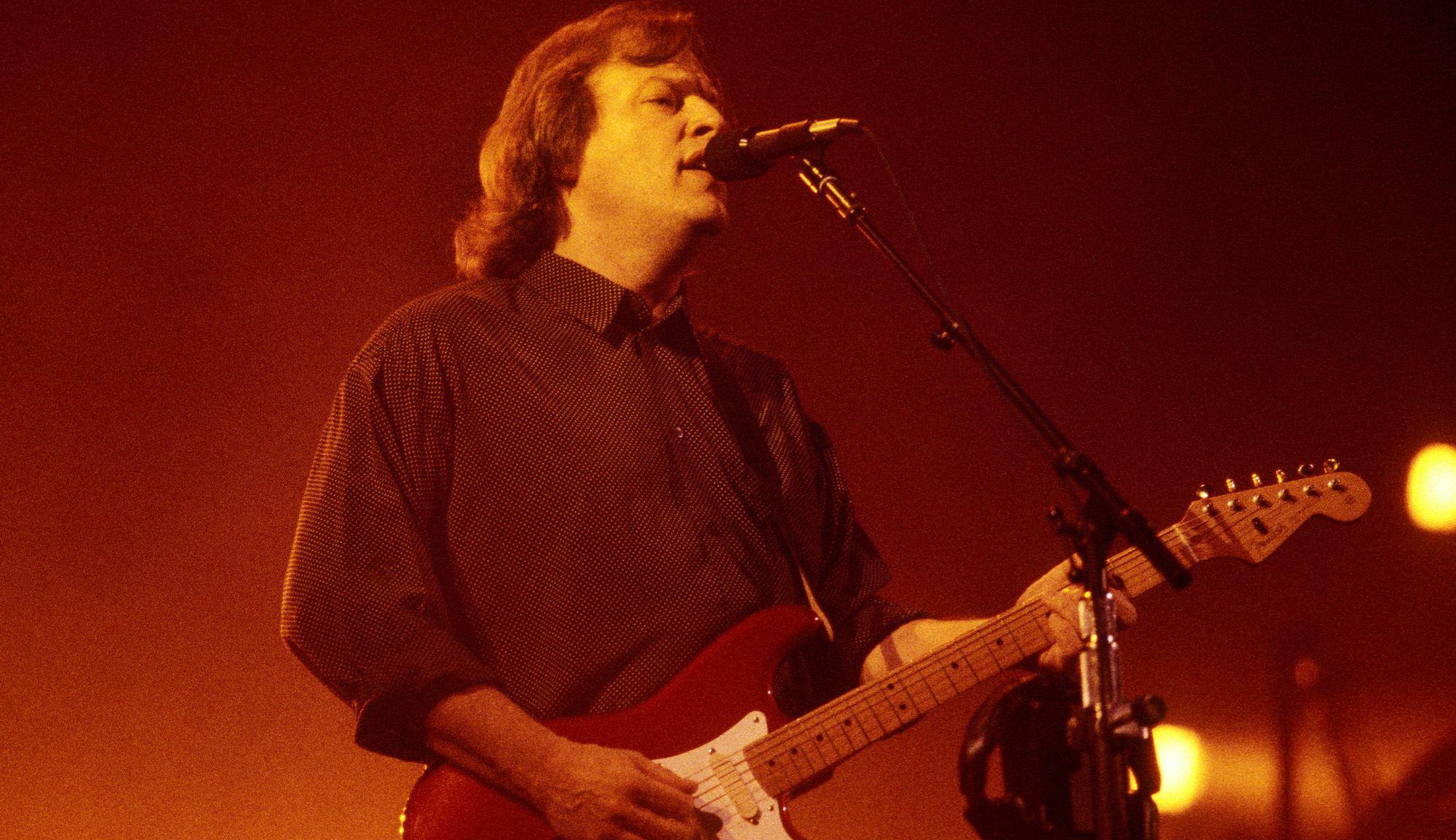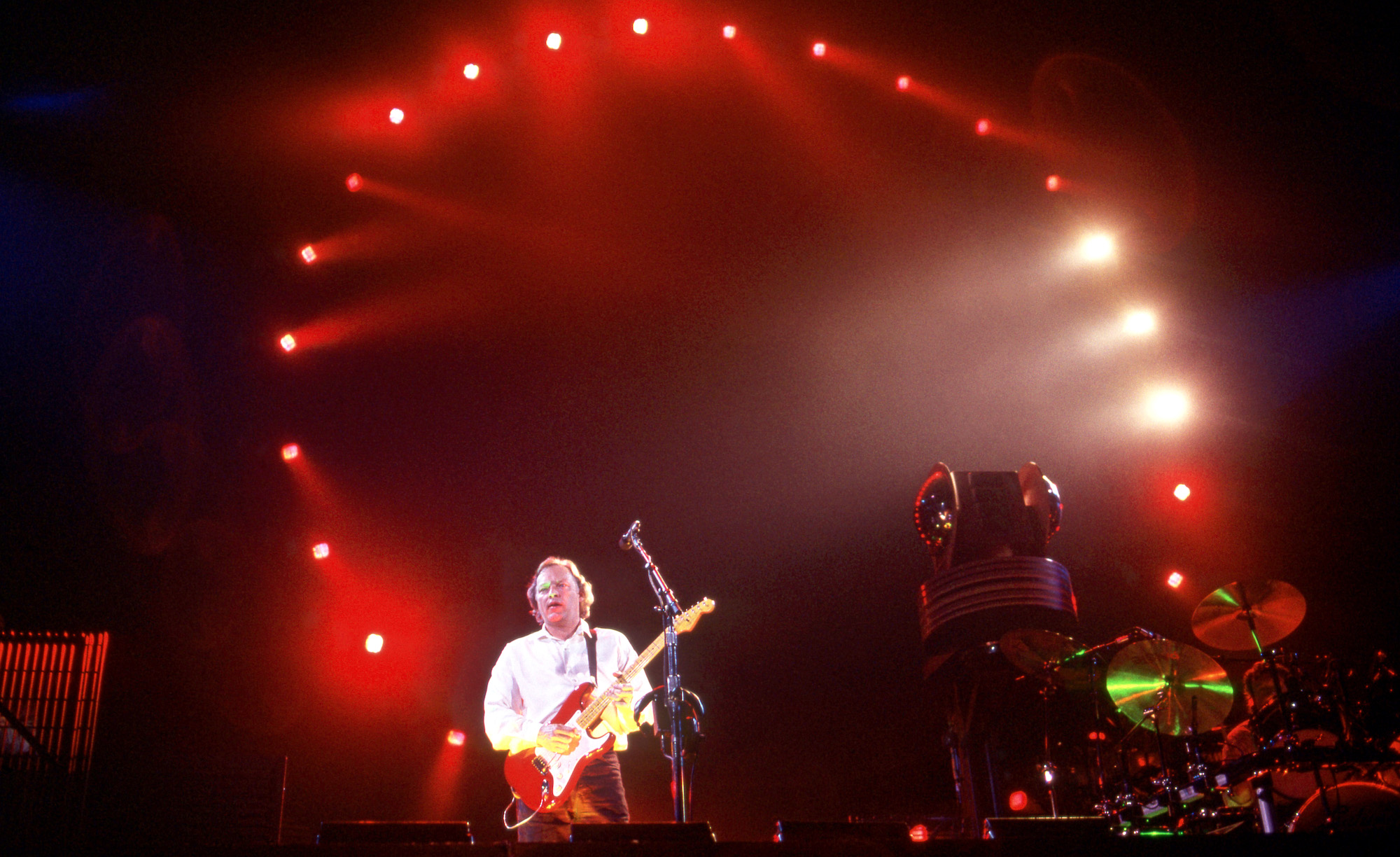"I like to approach every track and every solo I do with an open mind": David Gilmour discusses his blues influences, Steinbergers, his oft-imitated tone and more in 1988 GW interview
The Pink Floyd legend also reveals his admiration for Eddie Van Halen and Steve Lukather, and why he likes to keep things spontaneous in the studio

The following is an interview with Pink Floyd's David Gilmour, taken from the July 1988 issue of Guitar World, which featured Eddie Van Halen on the cover. The original story ran with the headline, David Gilmour: Absolute Sound.
It's 2010. A joint Soviet-American space mission has successfully established a sprawling colony of settlers on the moon. The two dozen cosmonauts, astronauts, scientists and assorted astronomers have been living in peace and harmony for nearly a year.
Their general consul, made up of an equal-numbered contingent of Yanks and Ruskies, has set up a series of laws by which all abide. And they have chosen a national anthem for their Lunaville home.
By majority vote, they picked Pink Floyd's Dark Side of the Moon, a 20th-century classic that is still, amazingly, surfacing in the Billboard charts back on Earth, nearly 40 years after its initial release.
David Gilmour, guitarist extraordinaire and only surviving member of Pink Floyd, is in his mid-sixties and still an active recording artist. [Editor's note: In case it was not evident from references to the Soviet Union still existing in 2010, this passage is satirical and hypothetical. David Gilmour is not the only surviving member of Pink Floyd.]
His latest release, Brain Spurs and Other Cognitille Mishaps, is riding high on the Billboard Next Age charts, and the hologram of his hit single, "I Put a Mind Probe on You," is selling particularly well in the Soviet Union.
Yet, in spite of the widespread popularity and critical acclaim he's enjoyed over the past 15 years as a solo artist, Gilmour still fondly recalls his days with the Floyd.
All the latest guitar news, interviews, lessons, reviews, deals and more, direct to your inbox!
The ever-selling Dark Side of the Moon holds a particularly special place in his memory banks, though when asked to list his favorite project over the last 40 years of his career, the sexagenarian axman says, "Well, you know – I really quite liked A Momentary Lapse of Reason. I think my playing was rather good on that one, actually."
I would tend to agree with Ol’ Man Gilmour on that. Sure, he has played some memorable solos since he joined Pink Floyd in late 1967 – Comfortably Numb from 1979's The Wall, Money from 1973's Dark Side of the Moon, Pigs from 1977's Animals, All Lovers Are Deranged from his 1984 solo project, About Face, to name just a few.
But on A Momentary Lapse of Reason, the first Floyd album where Gilmour is truly and forcefully in the driver's seat (freed as he is from the domineering influence of his old nemesis Roger Waters, who split the Floyd to pursue a solo career), the guy is absolutely killin' with that Strat.
Make that a Strat and a Steinberger. On the cut Sorrow, the man who has for so long been associated with Fender Stratocasters plugs in one of Ned's headless wonders, lays on the TransTrem and gets some earth-shaking results.

“That very nasty distortion you hear at the beginning of the song is basically the result of the Steinberger going through two little amps in the studio – a Fender Super Champ and a Gallien-Krueger. I use a Boss Heavy Metal distortion pedal and a Boss digital delay pedal, which then goes into the Fender Super Champ. And that in combination with the internal distortion on the Gallien-Krueger was how I got that particular sound.
"Funny enough," he adds, "I wrote the lyrics for that song first. I sat at home one night – I was kind of hoping the music would come out of the air and the song would magically write itself. But it didn't. But I did write all the lyrics that night and the next day I went into the studio, plugged in the Steinberger and that was what came out.
There’s no devices, customized or otherwise, that give me my sound. It comes off my fingers
“I had no particular plan. I had just gotten the Steinberger and hadn't really played it all that much at that point. But I rather liked the sound it makes naturally. And then the combination of bending up with the wang-bar on whole chords while simultaneously fading in with a stereo volume pedal – that's the sound."
A very nasty sound indeed, guaranteed to please connoisseurs of "sick" guitar. Elsewhere on A Momentary Lapse of Reason, Gilmour plays his familiar red Strat with typical lyricism, cut with a definite blues bite.
His clean, economical lines on the instrumental Signs of Life (recorded direct to the desk with no effects whatsoever) features some classic Delta blues licks at the tag. And his piercing single-note work during his stinging exchanges with saxman Tom Scott on Terminal Frost is right out of the Albert Collins school of toe-curling blues riffs.
Gilmour admits a great love of the blues, but says that the key to his playing is his melodic sense. "Yes, there's a lot of the blues in my playing. When I was young, I actually sat down and learned many of the classic blues solos by Eric [Clapton] and Hendrix as well as studying old Howlin' Wolf records. But I don't consciously delve into that area now. Blues lines as such are fairly specific.
"It's like, you've got a series of things that you can put together in different combinations but there aren't that many moves you can make. Instead, I try to approach things, given my limitations and strengths, from a more melodic standpoint and just work on it until it sounds... nice.
"I don't really have any plan in hand that helps me to deal with this. I try not to be too tied down by rules and regulations. So the blues influence may come out at times but I like to think I come at it from a different angle."
Strengths?
"Oh, I'd say my sense of melody. My sense of going for the unusual at times."

Weaknesses?
"Well, I can't really play fast, per se. Not like so many players today. I don't have a very disciplined approach to practicing or anything, but I do tend to have a guitar around most of the time, which I strum on most of the day. But about once a year I have sort of an attack of a guilty conscience about my abilities, so then I'll sit and run through a couple of scales. But generally, I'm not too ambitious about that sort of thing. I just tend to strap on the guitar in the studio and do something crazy.
I don't really approach anything with any great plan, except that I work on the sound until it sounds right to me
“Again, I don't have a very precise method of doing anything. I'm sorry, I feel like I'm being awfully vague about all this, but that's the way I am. I just play intuitively and work the same way in the studio. I don't have any magical effects or anything that helps me to get my particular sound. It's all very hard to explain. I just keep fiddling with the little knobs on different boxes until it sounds right to me.
"I like to approach every track and every solo I do with an open mind. I don't really have any kind of general philosophy of playing, I don't think. And to be honest with you, I can't really remember how I achieved certain sounds in the studio. I don't really approach anything with any great plan, except that I work on the sound until it sounds right to me – forgetting instantly afterwards how on earth it was done."
Okay, thanks for the workshop, Dave.
In this day and age of neo-classical metal-whatever, where young (and I mean young, like 18) guitar daredevils are racing up and down the neck at inhuman speeds, skipping across strings like Evel Knievel hurtling a row of school buses on his cycle, blazing through scales and arpeggios like sewing machines on automatic pilot, David Gilmour stands out as an anomaly.
Call him a throwback, a dinosaur, a relic, if you will. But for my money, he could teach these young whippersnappers a thing or two about phrasing, about finesse and taste, about making a personal statement on the instrument, not through any magical gadgets but through one’s own personal touch – bare fingers on strings.
“One thing about my guitar sounds,” offers the humble Floydman of few words, "I think I could walk into any music shop anywhere and with a guitar off the rack, a couple of basic pedals and an amp I could sound just like me. There’s no devices, customized or otherwise, that give me my sound. It comes off my fingers. It all comes down to personal taste, I guess.
"Like vibrato, for instance. I like a kind of refined version, which I do either with a finger or with a wang bar – sometimes both at the same time. But I must say that a lot of vibrato that's used today just doesn't appeal to me at all. It doesn’t sound musical."
Being a rich, semi-reclusive Englishman with a country home and family, Gilmour doesn't spend much time making the scene in London, New York or L.A., hanging with the cats, keeping up with the latest trends in music, the newest innovations in technique.

He admits, for instance, to never having heard Yngwie Malmsteen or any of the clones who spun off from that school of playing. But he admits, "I do like Eddie Van Halen's playing a lot. Of course, I can't do that at all. I don't have the fingers for it."
Other players he admires?
"Steve Lukather is great. I really love his playing. I love a lot of people's playing, but I mostly tend to like some of the old guys, you know? Eric, Jeff Beck, people like that. They're more to my taste.”
His taste coming basically out of the blues while young turks like Yngwie and his ilk basically shun the blues in favor of classical scales. As far as Gilmour is concerned, you can keep your Paganini scales and flourishes.
He prefers the simple boogie-woogie of John Lee Hooker and the dirty urban blues of Muddy Waters, which he pays tribute to on Dogs of War, a sort of symphonic slow boogie blues with a whole section of sample cellos droning that familiar ostinato riff.
Simple, yes, but full of feeling, especially when Gilmour sails over the top with his distinctive stereo delay sound, warm and slightly wet, as opposed to the standard dry, treble-piercing shrieks that many young guitar phenoms seem to prefer today.
Yeah so Gilmour's a dinosaur. Fine. But I'll take his solo on Yet Another Movie over 90 percent of the flailing fretboard work on record today. Of all the tunes on A Momentary Lapse of Reason, this is perhaps his most thoughtful, well-crafted solo of the bunch. That, and his moving solo on the anthemic On the Turning Away, based on a traditional Celtic melody.
On both tunes he takes his time and builds the solos artfully. Rather than just a series of tricky licks, he seems to orchestrate his statements carefully for maximum emotional effect, and yet he doesn't work out these solos ahead of time. Gilmour's finest solos are like spontaneous compositions.
There's tension and release, statements and resolutions. And like Carlos Santana and the whole lineage of bluesmen from T-Bone Walker to Otis Rush to Eric Clapton, he knows how to squeeze every bit of juice out of a single note. He savors each note before going on to the next, and he comes up for air (take that, speedmongers).
I sound like a curmudgeon. I’m sorry, that's the way I feel. That's the way David Gilmour feels, too. We're both dinosaurs in this day and age. But if the old adage 'what goes around comes around' is actually true, Gilmour's music, that sound, will be around long after all the Yngwie clones have been put out to pasture.
After all, whose music did the joint Soviet-American colony on the moon choose for their national anthem? I rest my case.

Any parting advice to young guitarists, Dave?
"Well, it's very hard to advise people, but in general I would say listen to as many different types of music as you can. And don't worry. Let everything come out of you in whatever way feels right, rather than wasting a lot of time and energy in trying to be someone else. That's what I'm trying to do myself."
And succeeding quite well, I might add.
Momentary Ax Of Reason: Gilmour's Gear
David Gilmour is a renowned guitar collector. Over the years, with the help of his right-hand man, Phil Taylor, he has acquired such rare gems as a Gretsch White Falcon, a Gretsch Penguin, a Plexiglas Dan Armstrong, a '55 Fender Esquire, a Martin D-35 acoustic, a Fender Strat with the serial number 0040 that once belonged to Homer Haynes of the country duo Homer & Jethro, as well as several Rickenbacker Hawaiians dating back to 1933.
But perhaps his most prized possession is the Stratocaster that bears the serial number 0001. According to Taylor, "I don't think it's the original Strat – it'd be real hard to ascertain that. But it's definitely early, dated 1954 on the neck. I bought it from Seymour Duncan, who bought it from Leo Fender, and I sold it to David."
At one point in the not too distant past, Gilmour actually had a guitar gallery in his home in London. These ancient axes were hung on the walls for years, but now, as Taylor explains, "David is in the process of moving. The guitars are literally packed away in storage right now.
"It's pretty strenuous, really, taking charge of it all. We used to have a humidifier going at all times, thinking that it would keep the guitars in better shape, but to be honest, it kind of made the instruments a little rusty. So now, after David settles on a place to live, we'll re-assemble the collection."
"I haven't added anything to my collection in quite a long time," Gilmour continues. "And I haven't gotten around to selling some of the ones I should sell. Like, for instance, I have doubles on quite a few of them. I mean, you find one guitar you want, and then later you find a better version of that same one and before you know it, you have a whole roomful of them. But it's a little unfortunate that I've placed them all in storage, because I haven't got around to playing them."
Gilmour's touring guitars with Pink Floyd (and for a series of shows with Pete Townshend a couple of years ago) are six Fender Strats from the '57 vintage reissue series of a few years back.
Varying in colors from candy apple red to a creamy off-white, all are outfitted with EMG SA pickups and presence controls. Though Gilmour retains the standard Fender bridges, he has the vibrato arms shortened and re-bent so that he can palm the arm while he strums.
"David goes through hundreds of Strats,” Taylor explains. "He goes directly to the factory in California and picks them up and plays 'em. He knows exactly what he wants and plays them acoustically and sees no point in even plugging them in if they don't pass the acoustic part of his test. And they must have maple fingerboards, too; David's pretty adamant about that."
Gilmour also travels with a '61 Telecaster with a Charvel neck, which was pictured on the back cover of his 1984 solo album, About Face, as well as a '52 vintage series re-issue Tele for the song Run Like Hell. Add to that a couple of Steinbergers, outfitted with TransTrems, which Gilmour especially likes for spur-of-the-moment gigs around home.
"He likes to play with friends in clubs," Taylor explains, "but since he can't be hacking about with all these other guitars, the Steinbergers suit this real well." As far as acoustics go, Gilmour plays a couple of Takamines on tour ("can't remember the model number," Taylor laughs), as well as an Ovation Custom legend from '75. The Martin D35, which is a studio staple, has been deemed too precious to go on the road.
"I do believe David would flip out if anything happened to that one," Taylor suggests. Signal-wise, Gilmour is serious and methodical. While he might still be using his Bradshaw switching system when the Pink Floyd tour hits your town, a couple of component changes may occur.
"We're probably going to change a couple of things," Taylor projects. "The 19-inch effects might be getting lost. We are using a Boogie top as a valve overdrive – a very expensive foot pedal!
"And we have a custom-made fuzz box made by [English effects systems builder] Pete Cornish, like a Big Muff. Most of the time David is unhappy with his sound, even when everyone thinks it's wonderful."

In the studio, Gilmour likes to tinker around and get his sound as quickly and as easily as possible. He plugs into a Boss CS-2 compressor, a T.C. 2290 for delay and a Yamaha SPX90 for stereo chorus. Then it's into a Gallien-Krueger 250Ml amplifier at an overdriven setting into a Fender Super Tube amp at a clean setting.
"A lot of the time," Taylor explains, "David will be right in the control room with the amp right there on the floor as he plays. I guess he likes that immediacy of the sound. It's a good way of knowing where you're at!"
